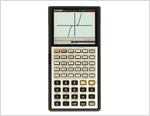The billionth Casio calculator
By Murray Bourne, 29 Apr 2007
Casio announced that it has sold its billionth calculator.
The first calculator I ever used was given to me as a gift. It blew me away with its power and versatility. I could immediately see that it would change mathematics - and mathematics education - forever.
And indeed, there was a revolution in mathematics during the 80s and 90s, as conservative mathematics instructors grudgingly allowed their students more freedom to use their calculators. Now it is a ubiquitous feature of most mathematics learning situations.
A key issue with calculator use is their growing sophistication. My daughter's calculator can do basic calculus (differentiation and integration). Is it fair that she uses that calculator in her exams, while the person next to her does not have those particular features on their calculator?
Most institutions do not allow calculators with a keyboard (QWERTY) or memory into examinations, in an attempt at fairness. But if we stop seeing exams as memory exercises and more as opportunities for students to display what they can achieve with appropriate resources, then these policies may need to be re-examined.
When I started using computer algebra systems in the early 1990s, it blew me away even more than my initial calculator experience did. The extraordinary power that CASs give us to visualize, explore, experiment with and check mathematics totally changed my outlook. I really started to question why we push students through mountains of algebra and then find that many of them cannot use any of it. Isn't it better to learn how to solve real problems with computer algebra systems, rather than to have the ability to perform algebraic tricks?
You may wish to see my earlier related post: Dinosaur Mathematics.
Alternatively you may also find this Calculator Buying Guide helpful.
See the 2 Comments below.

1 May 2007 at 2:50 am [Comment permalink]
Right you are! Actually we students should be given tools to help, not props to fiddle. We have to be like detectives, I sometimes think.
Of course some courses, such as certain branches of physics, require various advanced skills but it had better leave those skills to those interested.
1 Feb 2008 at 10:35 am [Comment permalink]
i totally agree with you. actually , those pupils must be provided with gadgets to assist, instead of stuff to play with. We must be serious detectives, and not fiddle around with props like noobs.
Definitely, some physics lessons, that need many high tech skills, which i am lacking of, are too hard for people like me to master****..........
thats why, i love to M!!!